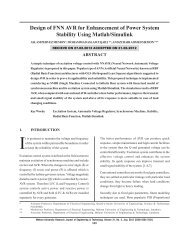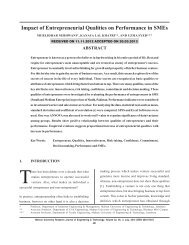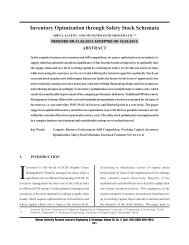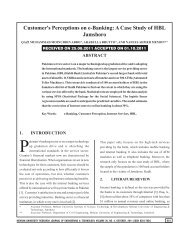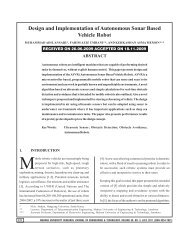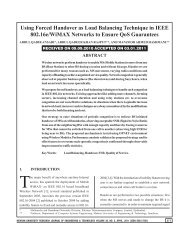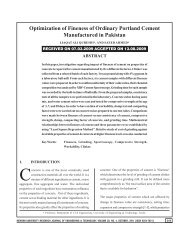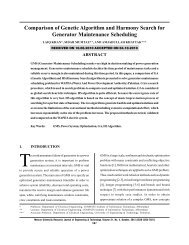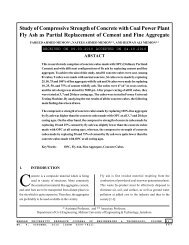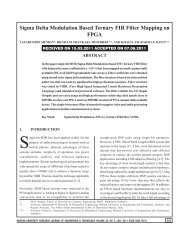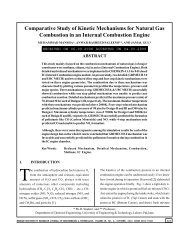(Mazhar Peerzada-Anwar Tanwari-Sadaf Aftab Abbasi). - Mehran ...
(Mazhar Peerzada-Anwar Tanwari-Sadaf Aftab Abbasi). - Mehran ...
(Mazhar Peerzada-Anwar Tanwari-Sadaf Aftab Abbasi). - Mehran ...
- No tags were found...
You also want an ePaper? Increase the reach of your titles
YUMPU automatically turns print PDFs into web optimized ePapers that Google loves.
Characterization of Low Twist Yarn: Part-I Effect of BlendRatio (Polyester/Cotton)MAZHAR HUSSAIN PEERZADA*, ANWARUDDIN TANWARI**, SADAF AFTAB ABBASI*RECEIVED ON 24.12.2011 ACCEPTED ON 15.03.2012ABSTRACTThe present study was conducted to determine the impact of PE/CT (Polyester/Cotton) blend ratio on thelow twist yarn properties. A range of yarn count with similar low twist was spun on ring machine with 70/30 and 30/ 70 PE/CT blend ratios. The yarn properties such as evenness, hairiness and strength werestudied. It was observed that single end yarn and skein strength, elongation and hairiness were directlyproportional to the ratio of polyester fibre in the blend. It was revealed from the experimental findingsthat the evenness and strength improved with an increase of proportion of polyester fibre. They alsoincreased with increasing yarn count.Key Words:Ring Spinning, Low Twist Yarn, Cotton, Polyester, Strength and Hairiness.1. INTRODUCTIONThe world has entered to more fashion-orientedera and that is changing consumers' clothingdemands such as great versatility, higherstandards and precision in fabrics. All these demands maynot be fulfilled by only cotton fibre. This is because cottonalone does not provide easy care, wash and wear withlonger life of the textiles. In order to overcome this problemand meet the consumer demands the natural fibres suchas cotton are blended with the synthetic fibres such aspolyester.Blending of PE/CT fibres has the prime importance due toits multiple end uses and economical productivity. Thebest way of blending staple fibres is on with the drawframeduring pre-spinning processes, because that giveslongitudinal blending. It was investigated by Nawaz et althat the percentage of polyester increases the strength ofblended yarn and the strength deceases as the sharedecreases [1]. Li , et. al. [2] reported that fibre propertiesplay an important role by maintaining the yarn strength.Anandjiwala, et. al. [3] investigated that the blending ofdissimilar fibres increases the non-uniform distribution inthe yarn cross section which can lead to preferentialmigration depending on both fibre properties andmechanism of certain spinning processes. Fibre propertiessuch as type, length, fineness, coefficient of friction playa vital role in fibre migration during twisting [4-13].Twist isapplied to hold the fibres together and give strength tothe yarn. Generally, yarn strength increases with anincrease in yarn twist up to certain limit, beyond which thestrength starts decreasing [14]. The main objective of thisresearch was to find out the impact of 70/30 and 30/70* Assistant Professor, and ** Professor,Department of Textile Engineering, <strong>Mehran</strong> University of Engineering & Technology, Jamshoro.<strong>Mehran</strong> University Research Journal of Engineering & Technology, Volume 31, No. 4, October, 2012 [ISSN 0254-7821]613
Characterization of Low Twist Yarn: Part-I Effect of Blend Ratio (Polyester/Cotton)PET/CT blend ratios on the evenness and tensile propertiesof a range of low twist yarn counts.2. MATERIALS AND METHODCotton and polyester fibres were used as raw material.The raw material properties were tested using USTERFibrograph, Stelometer and Micronaire equipment and theresults are given in Table 1. The two PE/CT blending ratioswere 70/30 and 30/70. Both fibres were mixed on the Rieterdraw-frame RSB-D35. The low twist yarns were finallyproduced with three different counts, i.e. 30, 40, 50 tex.The low twist yarns were spun with 230 turns/meter onring spinning machine EJM 168 using 15000 rpm spindlespeed. The general samples plan is shown in Fig. 1.The textile yarn properties were measured usingcomputerised testing machines - Uster Tensorapid 4 andUster Tester 4 by using the standard procedure. Beforetesting the samples were conditioned at 65 ± 2% and 20 ±2 o C for at least 24 hours. Minimum 10 samples for eachcount were tested according to ASTM (American Societyfor Testing and Materials) standards [15-18].3. RESULTS AND DISCUSSION3.1. Analysis of Low Twist Yarn EvennessThe mass variation, coefficient of variation, uniformityindex and hairiness (Fig. 2) of low twist yarns with a rangeof count were measured. Blend ratio was the main criteriafor assessing the quality of yarn. Figs. 2(a-b) show thatU% (Mass Variation) and CV% (Coefficient of Variation)was decreased in the yarn made with higher polyesterratio (70/30). Count 50 exhibited highest decrease in U%and CV% comparing to other yarn counts. This decreaseleads to increase in the yarn strength. U% and CV% remainalmost same in all yarn counts made with 30/70 blend ratio.However yarn count 50 had slightly lower CV%.The LT yarn made of 70/30 ratio appeared with higheruniformity index, Fig. 2(c). The yarn count 50 tex showedhighest index among other yarn counts. The hairiness ofyarn Fig. 2(d), present almost similar values. The LT yarnmade with 70/30 ratio showed lower hairiness percentageas comparing with yarns made with 30/70 blend ratio. Thisis due to lower proportion of cotton fibres.3.2. Tensile Properties of Low Twist Yarn3.2.1 Single Yarn StrengthSingle yarn tensile properties were evaluated and theresults are shown in Fig. 3. The figure shows that yarnsmade with 70/ 30 blend ratio are stronger as comparedto yarns made with 30/ 70 blend ratio. Though, yarnstrength and breaking force, Fig. 3-(a-c), increase withan increase of yarn count in both blend ratios. Yarncount 50 (70/30) possesses highest strength andbreaking force. The Fig. 3(c), reveals that all yarnFIG. 1. SCHEMATIC DIAGRAM OF EXPERIMENT PLANTable 1. Properties of Cotton and Polyester FibresNo. Cotton Fibre Properties Measurement Polyester Fibre Properties Measurement1. Fibre Tenacity 32 g/tex Denier 1.22. Uniformity Index (%) 83% Tenacity 7.2 gm/den3. Mic Value 4.3 Elongation 20%4. Length (mm) 28mm Crimps/cm 6.5Fibre length38mm<strong>Mehran</strong> University Research Journal of Engineering & Technology, Volume 31, No. 4, October, 2012 [ISSN 0254-7821]614
Characterization of Low Twist Yarn: Part-I Effect of Blend Ratio (Polyester/Cotton)counts in both blend ratios have almost similarelongation percentage. However the yarn count 50 tex(70/30) had higher elongation percentage whencompared with the same yarn count in 30/70 blendratio and other counts in both blend ratios. This meansthat yarn count 50 exhibited favourable tensilebehaviour with low twist.3.2.2 Lea StrengthFig. 4 illustrates the comparison of tensile properties ofyarns (lea strength) of different blend ratios and counts.Fig. 4(a) reveals that yarns made of 70/30 blend ratiopossess higher strength than that of the 30/70 blendratio. The strength in 70/30 yarns increases significantlywith increase in yarn count. Yarn count 30 and 40 in 30/70 blend ratio possess lowest strength if compared withall yarns in both blend ratios. The elongation behaviourFig. 4(b), shows similar behaviour as was revealed forstrength. The yarn count 50 in 70/30 blend ratio possesseshighest elongation among all types of yarns. The Fig.4(c) shows that the yarn made of 70/30 blend ratioexhibited higher breaking force comparing to the yarnsof 30/70 blend ratio. And yarn count 50 possesses thehighest breaking force.4. CONCLUSIONSA comparative study has been carried out to analyse theeffect of polyester/cotton blend ratio (70/30 and 30/70) inlow twist (230 turns/meter) yarn with a range of yarn counton yarn evenness and tensile behaviour. Compared to(a) MASS VARIATION(b) COEFFICIENT OF VARIATION(c) UNIFORMITY INDEX(D) HAIRINESSFIG. 2. PROPERTIES OF LOW TWIST YARN SPUN WITH 70/30 AND 30/70 BLEND RATIOS<strong>Mehran</strong> University Research Journal of Engineering & Technology, Volume 31, No. 4, October, 2012 [ISSN 0254-7821]615
Characterization of Low Twist Yarn: Part-I Effect of Blend Ratio (Polyester/Cotton)yarn count 30, 40 and 50 made with 30/70 blend ratio, lowtwist yarns made with 70/30 ratio had improved yarnproperties such as U%, CV%, Hairiness, Single end andskein strength. This advantage is mainly due to lowerratio of cotton fibres and higher proportion of polyesterfibres in a low twist yarn.(a) ULTIMATE STRENGTH(a) ULTIMATE STRENGTH(b) ELONGATION(b) ELONGATION(c) BREAKING FORCE(c) BREAKING FORCEFIG. 3. COMPARISION OF TENSILE PROPERTIES OFSINGLE LT YARNS MADE OF 70/30 AND 30/70 BLENDRATIOSFIG. 4. COMPARISION OF TENSILE PROPERTIES OF LTYARNS MADE OF 70/30 AND 30/70 BLEND RATIOS<strong>Mehran</strong> University Research Journal of Engineering & Technology, Volume 31, No. 4, October, 2012 [ISSN 0254-7821]616
Characterization of Low Twist Yarn: Part-I Effect of Blend Ratio (Polyester/Cotton)The yarn count 50 exhibits improved strength, U%, CV%and hairiness among the yarn types of 70/30 blend ratio.Usually, hairiness and strength largely depends on thelevel of yarn twist. However, the results showed thatvariation in blend ratio may also affect yarn evennessand tensile properties. This may attribut to highpercentage of polyester with respect to the fibre strengthand staple length i.e. all polyester fibres have similarstaple length.ACKNOWLEDGEMENTThe authors would like to thank Dr. Zulfiquar Ali,National Textile University, Faislabad, Pakistan, forhelping to arrange material to carry out the experimentalwork.REFERENCES[1] Nawaz, S.M., Shahbaz, B., and Yousaf, C.K., "Effect ofDifferent Blends With Various Twist Factors on theQuality of PLC Blended Yarn", Pakistan Textile Journal,Volume 48, No. 6, pp. 26-29, 1999.[2] Li, Y., and Yan, H., "Measuring Unevenness and BlendRatios of Yarns with Microwave Resonators", TextileResearch Journal, Volume 60, No. 1, pp. 54-55, 1990.[3] Anandjiwal, R., and Goswami, "Structural PropertyRelationship of Blending Cotton Yams Made from Lowand High Tenacity Fibres", Textile Research Journal,Volume 69, No. 2, pp. 130-137, 1999.[6] Ghosh, S., Rodgers, J.E., and Ortega, A.E., "Rotor RingMeasurement of Fiber Cohesion and Bulk Properties ofStaple Fibers", Textile Research Journal, Volume 62,pp. 608-613, 1992.[7] Hamilton, J.B., "The Radial Distribution of Fibres inBlended Yarns, Part-I: Characterization by a MigrationIndex", Journal of Textile Institute, Volume 49,pp. 411-423, 1958.[8] Hua, V.M., "Fiber Migration in Spinning", Journal ofChina Textile University, Volume 8, pp. 1-6, 1991.[9] Lang-Michaut, C., "Pratique des Tests Statistiques:Interprétation des Mesures," Dunod, pp. 109, Paris,France, 1990.[10] Mortan, W.E., "The Arrangement of Fibers in SingleYarns", Textile Research Journal, Volume 26,pp. 325-331, 1956.[11] Scardino, F.L., and Lyons, W.J., "Fiber Surface Propertiesin Relation to Linear Assemblies During Processing, Part-I: General Considerations; Results on the WorstedSystem", Textile Research Journal, Volume 37,pp. 874-880, 1967.[12] Scardino, F.L., and Lyons, W.J., "Influence of FiberGeometry on the Mechanical Properties of AssembliesDuring Processing, Part-I: Polyester Fibers in Webs andSlivers", Textile Research Journal, Volume 40,pp. 559-570, 1970.[4] El-Mogahzy, Y.E., "Setting Practical Scientific Criteriafor Cotton Fiber Selection and Blending, in BeltwideCotton Conferences", National Cotton Council,Memphis, pp. 691-694, USA, 1998.[13] Townend, P.P., and Dewhirst, J., "Fibre Migration ofViscose Rayon Staple-Fibre Yarns Processed on theBradford Worsted System", Journal of Textile Institute,Volume 55, No. 10, pp. 485-502, 1964.[5] Ford, J.E., "Segregation of Component Fibres in BlendedYarns", Journal of Textile Institute, Volume 49,pp. 608-620, 1958.[14] Palaniswamy, K., and Mohamed, P., "Yarn Twisting",AUTOTEX Research Journal, Volume 5, No. 2, June,2005.<strong>Mehran</strong> University Research Journal of Engineering & Technology, Volume 31, No. 4, October, 2012 [ISSN 0254-7821]617
Characterization of Low Twist Yarn: Part-I Effect of Blend Ratio (Polyester/Cotton)[15] ASTM Committee, "Standard Test Method forUnevenness of Textile Strands Using Capacitance TestingEquipment", ASTM Designation: D1425-96, ASTMStandard on Textile Materials, American Society forTesting and Materials, Philadelphia, USA, 2004.[17] ASTM Committee, "Standard Test Method for TensileProperties of Yarns by the Single-Strand Method", ASTMDesignation: D2256-02, ASTM Standard on TextileMaterials, American Society for Testing and Materials,Philadelphia, USA. 2004.[16] ASTM Committee, "Standard Test Method for BreakingStrength of Yarn in Skein Form", ASTM Designation:D1578-93, ASTM Standard on Textile Materials,American Society for Testing and Materials,Philadelphia, USA, 2004.[18] ASTM Committee, "Standard Guide for MeasuringHairiness of Yarns by the Photo-Electric Apparatus",ASTM Designation: D5647-95, ASTM Standard onTextile Materials, American Society for Testing andMaterials, Philadelphia, USA, 2004.<strong>Mehran</strong> University Research Journal of Engineering & Technology, Volume 31, No. 4, October, 2012 [ISSN 0254-7821]618



